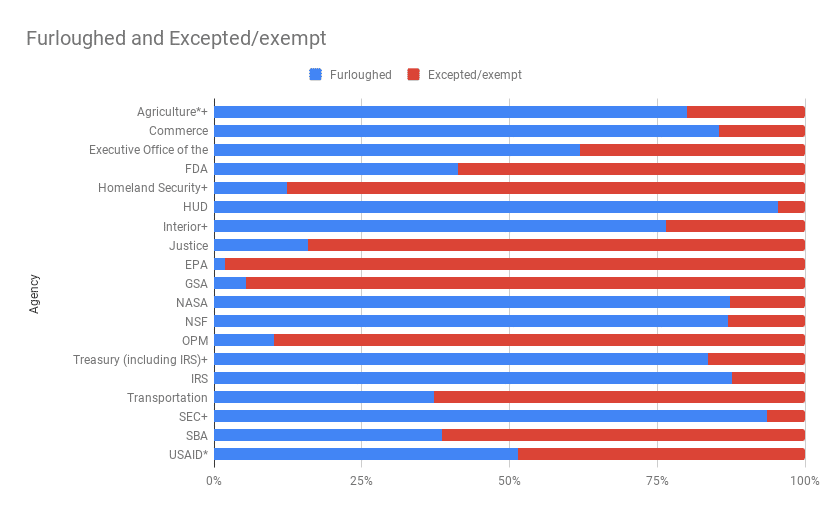
Will the government shut down? Will feds get a raise? The possibilities are endless.
Congress has less than a week before funding for some federal agencies expires on Dec. 21. Will the government close? Will federal employees get a pay raise in...
Congress has just seven days now to finalize funding for several agencies and avoid a partial government shutdown, and it’s anyone’s guess at what the outcome will be past the Dec. 21 deadline.
Six out of the seven remaining appropriations bills are nearly finished. But the homeland security appropriations bill — and the prospects for a border wall along the southern border — is the sticking point for Congress and the White House.
President Donald Trump had said earlier this week he “would be proud” to shut down the government if lawmakers didn’t agree to appropriate $5 billion for a border wall.
The House isn’t expected to return to Capitol Hill until Wednesday, Dec. 19. When it does, lawmakers in both chambers will consider one of a few different scenarios:
- A continuing resolution for all unfunded agencies that extends the shutdown deadline past Dec. 21,
- A “minibus” with the six finished appropriations bills and some sort of continuing resolution for the Department of Homeland Security,
- A “minibus” for the six appropriations bills and a partial shutdown for DHS only, or
- A partial government shutdown.
Of course, not all federal employees would experience the impacts of a partial government shutdown. Federal workers at the departments of Defense, Labor, Health and Human Services and Veterans Affairs already have full-year funding for fiscal 2019 at their agencies.
Only those agencies that are covered under these seven remaining appropriations bills would feel the effects.
- Commerce, Justice, Science and Related Agencies
- Interior, Environment and Related Agencies
- Financial Services and General Government
- Agriculture, Rural Development, Food and Drug Administration and Related Agencies
- Homeland Security
- Transportation, Housing and Urban Development and Related Agencies
- State, Foreign Operations and Related Agencies
If Congress allows funding to expire on Dec. 21, more than 380,000 employees would be furloughed, according to an estimate from the Senate minority appropriations staff.
More employees, however, would be forced to work without pay during a partial government shutdown, though Congress, as they have during past lapses in appropriations, will likely pass legislation later that would give impacted employees back pay.
Here is a breakdown of the percentage of employees that would be furloughed from each agency or department in the event of a partial government shutdown in December.
These numbers are approximate. Not every agency has updated its contingency plan in 2018, and some departments haven’t provided an estimate for every subcomponent.

*For some agencies, the number of furloughed employees changes depending on the length of the government shutdown.
+ Agencies who haven’t updated their contingency plans in 2018.
What about the pay raise?
The funding uncertainty also has implications for federal employees’ pay in the new year. The events of the next few days will impact paychecks for all civilian employees in 2019, regardless of whether your agency would be affected by a partial government shutdown in December.
Unless Congress acts in some way before the end of the year, the president’s proposed pay freeze for civilian employees will likely go into effect on Jan. 1.
But a pay freeze for 2019 isn’t final by any means, and federal employees should watch for one of several possible events in the final weeks of the month.
The president must issue an executive order by the end of the year to finalize his decision on pay for civilian employees. This typically comes toward the end of December before the Christmas holiday.
Of course, Trump could change his mind from his initial pay freeze announcement from August. That has happened before in recent memory, when President Barack Obama approved a 2.1 percent raise for civilian employees in 2017, achieving last-minute parity with members of the military.
House Republicans announced in October they had reached a deal to secure a 1.9 percent raise for civilian employees, but the agreement still isn’t public yet. The conference committee that formed in September to reconcile the differences between the House and Senate versions of several appropriations never released.
If the financial services and general government bill does, in fact, contain the 1.9 percent raise — and Congress manages to pass a minibus of appropriations measures before the deadline next week, civilian employees may get a raise in 2019.
But if Congress passes a continuing resolution or fails to move anything at all, the situation becomes more complicated.
A CR could contain the pay raise, which federal employee organizations are advocating for, or it could not.
If Congress fails to find a solution by the 21st and triggers a partial government shutdown, the prospects of a pay raise in 2019 diminishes. Lawmakers could include a raise for civilian employees in whatever spending measure they pass after the new year. But the pay bump may only cover the remaining months of 2019, unless Congress were to specify a retroactive pay raise.
End-of-year leave
A partial government shutdown may also have an untimely impact on federal employees’ leave. Many federal workers will have scheduled leave during the holiday season and end of the year.
“Non-excepted” or “non-essential” employees can’t use leave if they’re furloughed during a partial government shutdown, according to guidance from the Office of Personnel Management.
“Excepted” or “essential” employees would have their leave canceled during a partial government shutdown. These employees must come to work or be considered “absent” without leave.
OPM has more guidance on leave and furloughs here.
Copyright © 2024 Federal News Network. All rights reserved. This website is not intended for users located within the European Economic Area.
Nicole Ogrysko is a reporter for Federal News Network focusing on the federal workforce and federal pay and benefits.
Follow @nogryskoWFED





